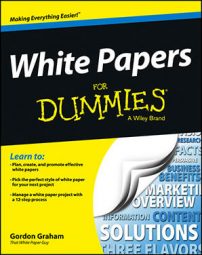When clients hire an advertising agency, the client often prepares a creative brief. A creative brief comes closer than anything to a white paper plan and is essentially a document that spells out the terms of reference for this kind of content marketing project.
A creative brief spells out many details to incorporate in that campaign, such as the purpose, audience, main take-aways, key competitive advantages, and any standard corporate messages, color palettes, logos, and the like.
Unfortunately, most companies never prepare any white paper plans, and their white papers suffer from this omission. Many teams are so rushed to get their white paper finished that they don’t start it properly.
In this step, the writer drafts a plan for the rest of the team to review. If any reviewers have comments, the writer updates the plan to reflect those comments until the client, all the reviewers, and the writer are completely satisfied with the plan.
| Step | Who | What |
|---|---|---|
| 3.1 | Writer | Creates draft white paper plan |
| 3.2 | Writer | Sends draft white paper plan to client |
| 3.3 | Client | Circulates draft white paper plan to all reviewers with deadline for comments |
| 3.4 | Reviewers | Comment on white paper plan |
| 3.5 | Client | Gathers all comments and resolves any differences |
| 3.6 | Writer | Refines white paper plan to incorporate comments |
| 3.7 | All | Repeat steps 3.2 through 3.6 until all reviewers are satisfied with white paper plan |
What the writer does for the white paper plan
The writer creates the white paper plan, which sets out the terms of reference for the project, including the purpose, audience, call to action, flavor, keywords, title, high-level outline, and any other characteristics of the document. The client circulates the draft plan to all reviewers for their comments, and then the writer refines it. Drawing up this blueprint puts the whole project on solid ground and helps it to succeed.
What the client does for the white paper plan
The client receives the draft white paper plan from the writer and circulates it to all the reviewers, with a fairly short deadline for getting their comments back, probably a week or less. No matter how busy people are, they can usually look at a one- or two-page plan for a few minutes.
When the comments come back, the client reviews them to make sure they make sense and gives the writer some notion of how to deal with them. If some comments can be safely ignored, the client tells the writer so.
Key elements of a white paper plan
An effective white paper plan should include all the following items:
The primary goal for the document
The target audience, including demographics, psychographics, and technographics, or a set of personas
Where the audience sits in the sales funnel: at the top, just starting their research; in the middle, comparing different vendors; or at the bottom, close to making a purchase
The call to action, or what you want the ideal readers to do after they finish reading
The ideal flavor: a backgrounder, numbered list, problem/solution, or a mash-up between a numbered list and one of the others
The target keywords, or the search terms you expect the ideal readers will use to find the white paper
Two or three possible titles, to be tweaked as you go
An official list of reviewers
A list of background material available from the client
Likely sources for further research: articles, associations, blogs, forums, industry analysts, LinkedIn groups, magazines, recorded webinars, reports, reviews, slides decks, or websites
A high-level overview of the recommended content
The writing tool to prepare the text with, usually Microsoft Word
The design tool to design the pages with, usually Adobe InDesign
Recommended page design guidelines
A realistic schedule for completing the project or else a real-world deadline that must be met

